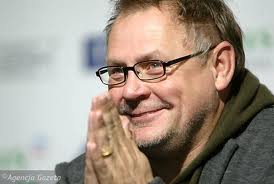The path to becoming an Academy Award-winning cinematographer sounds so easy when he talks about it before a packed auditorium of Art Center students, faculty and staff.

Kamiński
Yesterday, award-winning cinematographer Janusz Kamiński was on campus to speak as part of the Film Department’s Distinguished Filmmakers Series. Faculty member Allen Daviau hosted the Q&A with the two-time Academy Award-winning cinematographer and director. Some of the most fascinating people in film come to campus as part of the series, and Kamiński was no exception.
Kamiński grew up in Poland, with his love of movies beginning as a boy. After immigrating to Chicago, Kaminski had a choice: becoming a laborer, or pursue an education. He chose film school.
After attending Columbia College (not associated with Columbia University) he moved to Los Angeles and completed his MFA at the American Film Institute. Kamiński had a friend who worked as an assistant to Diane Keaton, and after the actress viewed his reel, she hired Kamiński to film Wildflower, a made-for-TV movie.
Famed director Steven Spielberg saw Wildflower, and was interested in how quickly it was shot. He went on to hire Kaminski to film the award-winning Schindler’s List, and Kamiński has filmed every Spielberg movie since. And a few others, too.
The talk began with a viewing of the first and last ten minutes of Julian Schnabel’s The Diving Bell and the Butterfly. The beginning of the film is shot entirely from the viewpoint of Bauby, waking from a three-week coma. The end of the film again retreats into his world, depicting his reality as his brain begins misfiring and starts to shut down. The scenes used selective focus, skewed framing and hand cranking to portray the world as seen through Bauby’s one eye.
Kamiński noted that the film was much more linear between the opening and closing scenes. While the images were powerful and the story allowed for such unconventional techniques, he advised against going in this direction for too long or you lose the audience: “I was not interested in making an art film.”
Kamiński said he was grateful to work with Schnabel, who was not interested in conventional story telling and who had a sophisticated visual sense. “Most directors would have made a soppy, sentimental movie, Kamiński said. “I know I would have. I love sentimentality.”
Kamiński’s advice to students:
- “You have to be very proactive with how you get jobs. I always had my demo reel with me. I didn’t always have a car but I had my reel.”
- “Don’t be careful; just do it now. Be careful later.”
- “Watch the world around you. Notice how the light changes during the day. How are you going to create that world on a screen?”
And on working with Spielberg:
- “I have spent more time with him than with my previous two wives.”








